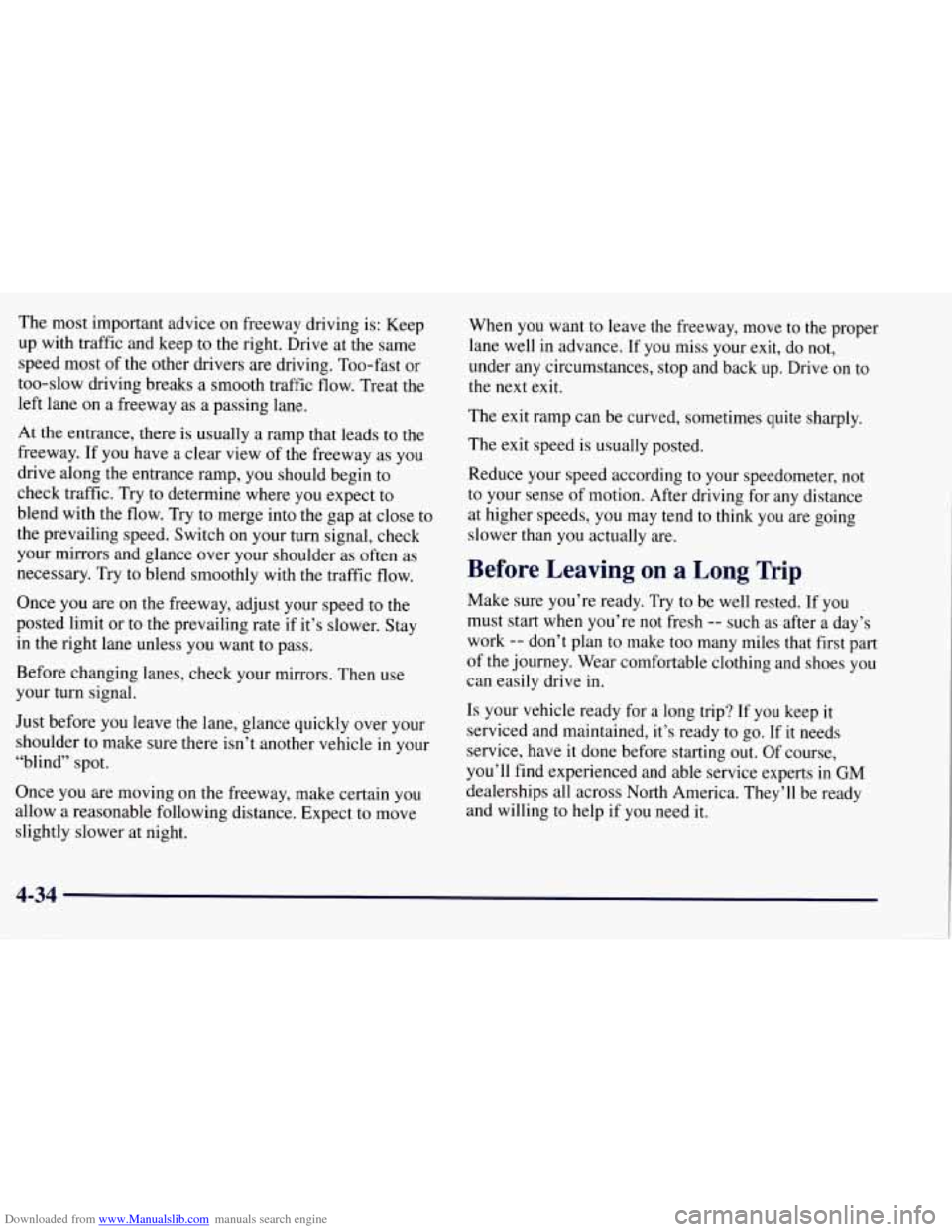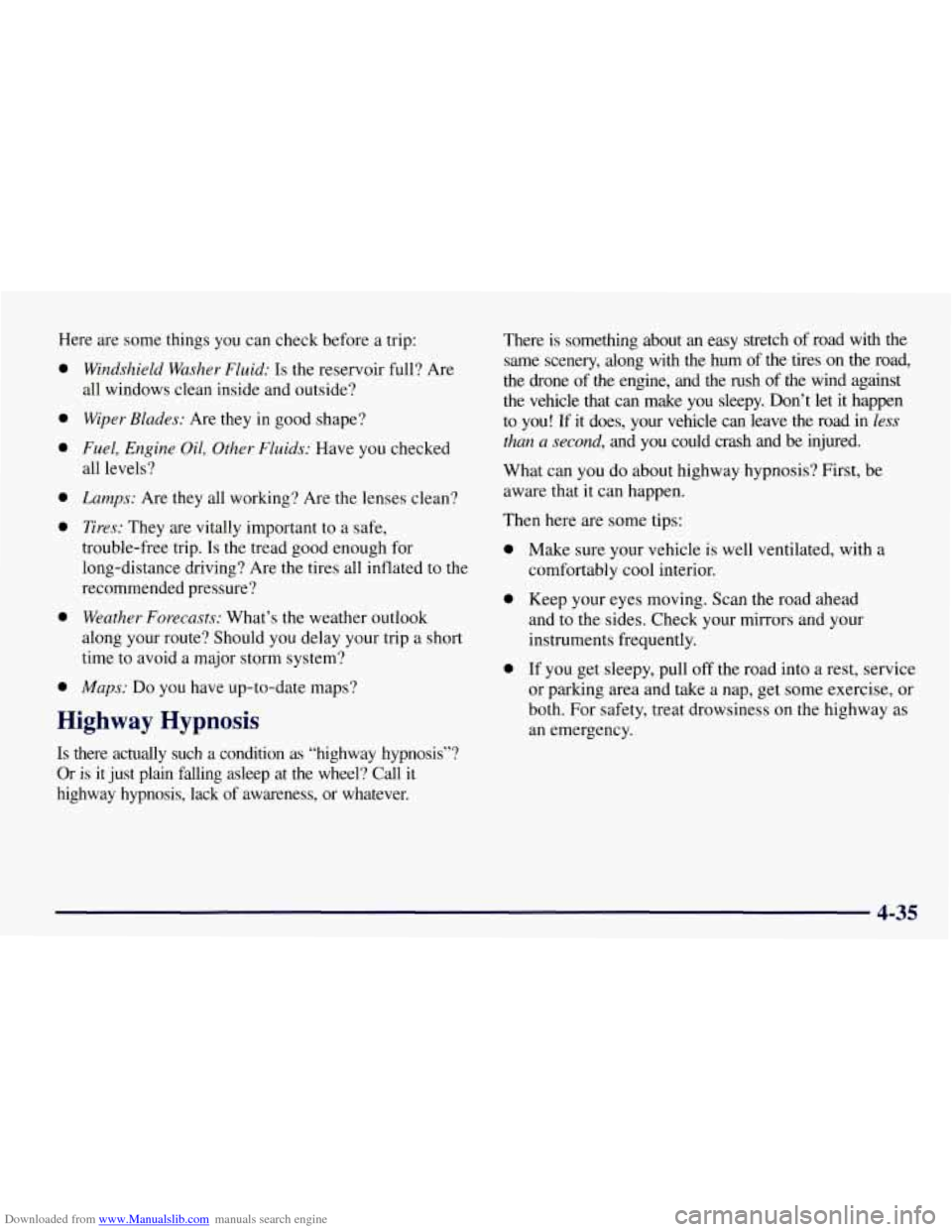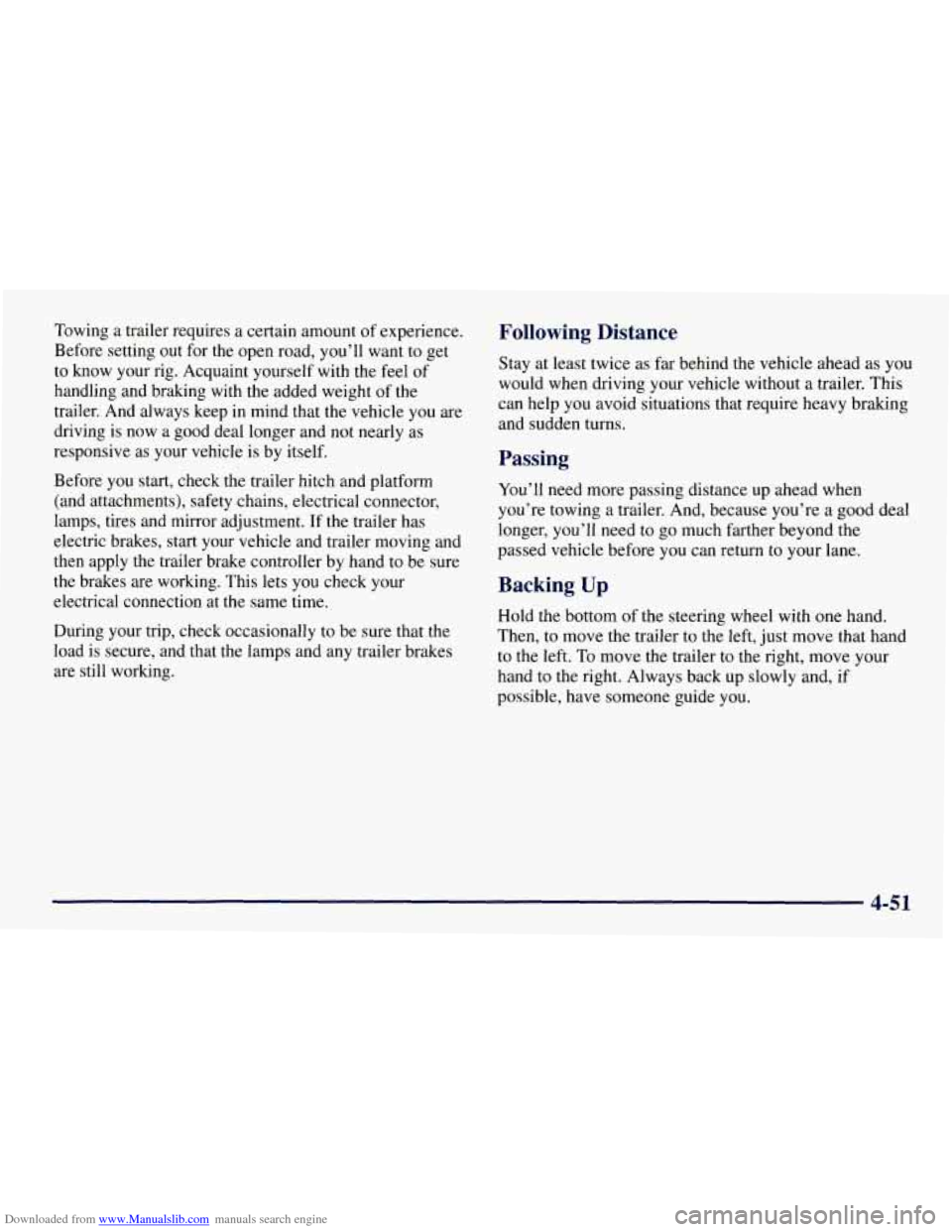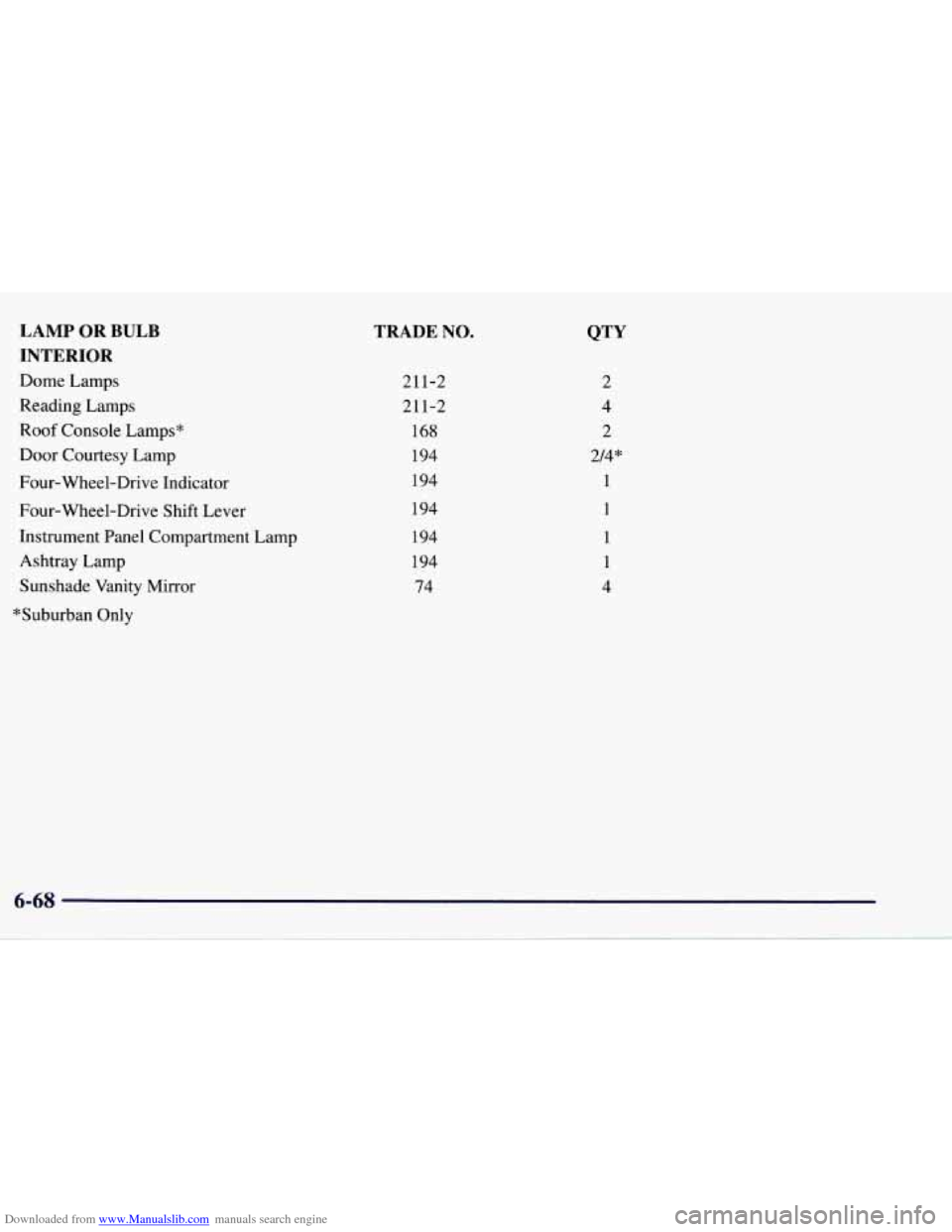1997 CHEVROLET TAHOE mirror
[x] Cancel search: mirrorPage 208 of 433

Downloaded from www.Manualslib.com manuals search engine Here are some tips on night driving.
0
0
0
0
0
0
0
Drive defensively.
Don’t drink and drive.
Adjust your inside rearview mirror to reduce the
glare from headlamps behind you.
Since you can’t see as well,
you may need to slow
down and keep more space between you and
other vehicles.
Slow down, especially
on higher speed roads. Your
headlamps can light up only
so much road ahead.
In remote areas, watch for animals.
If you’re tired, pull off the road in a safe place
and rest.
Night Vision
No one can see as well at night as in the daytime. But as
we get older these differences increase. A 50-year-old
driver may require at least twice as much light to see the
same thing at night as a 20-year-old.
What you do
in the daytime can also affect your night
vision. For example,
if you spend the day in bright
sunshine you are wise to wear sunglasses. Your eyes will
have less trouble adjusting
to night. But if you’re
driving, don’t wear sunglasses at night. They may cut down
on glare from
headlamps, but they also make a lot
of things invisible.
You can be temporarily blinded by approaching
headlamps. It can take a second or two, or even several
seconds, for your
eyes to readjust to the dark. When you
are faced with severe glare (as from a driver who
doesn’t lower the high beams, or a vehicle with
misaimed headlamps), slow down a little. Avoid staring
directly into the approaching headlamps.
Keep your windshield and all the glass on your vehicle
clean
-- inside and out. Glare at night is made much
worse by dirt on the glass. Even the inside of the glass
can build up a film caused by dust. Dirty glass makes
lights dazzle and flash more than clean glass would,
making the pupils of your eyes contract repeatedly.
Remember that your headlamps light up far less of a
roadway when you
are in a turn or curve. Keep your
eyes moving; that way, it’s easier to pick out dimly
lighted objects. Just as your headlamps should be
checked regularly for proper aim,
so should your eyes
be examined regularly. Some drivers suffer from night
blindness
-- the inability to see in dim light -- and aren’t
even aware
of it.
Page 213 of 433

Downloaded from www.Manualslib.com manuals search engine The most important advice on freeway driving is: Keep
up with traffic and keep to the right. Drive at the same
speed most of the other drivers are driving. Too-fast or
too-slow driving breaks a smooth traffic flow. Treat the
left lane on a freeway
as a passing lane.
At the entrance, there is usually a ramp that leads to the
freeway. If you have
a clear view of the freeway as you
drive along the entrance ramp, you should begin to
check traffic. Try to determine where you expect to
blend with the flow. Try to merge into the gap at close to
the prevailing speed. Switch on your turn signal, check
your mirrors and glance over your shoulder as often as
necessary. Try to blend smoothly with the traffic flow.
Once you
are on the freeway, adjust your speed to the
posted limit or to the prevailing rate if it’s slower. Stay
in the right lane unless you want to pass.
Before changing lanes, check your mirrors. Then use
your turn signal.
Just before
you leave the lane, glance quickly over your
shoulder to make sure there isn’t another vehicle in your
“blind” spot.
Once you are moving on the freeway, make certain
you
allow a reasonable following distance. Expect to move
slightly slower at night. When
you want to leave
the freeway, move to the proper
lane well in advance. If you miss your exit, do
not,
under any circumstances, stop and back up. Drive on to
the next exit.
The exit ramp can be curved, sometimes quite sharply.
The exit speed is usually posted.
Reduce your speed according to your speedometer, not
to your sense of motion. After driving for any distance
at higher speeds, you may tend to think you are going
slower than
you actually are.
Before Leaving on a Long Trip
Make sure you’re ready. Try to be well rested. If you
must start when you’re
not fresh -- such as after a day’s
work
-- don’t plan to make too many miles that first part
of the journey. Wear comfortable clothing and shoes you
can easily drive in.
Is your vehicle ready for a long trip? If you keep it
serviced and maintained, it’s ready to go. If it needs
service, have
it done before starting out. Of course,
you’ll find experienced and able service experts in
GM
dealerships all across North America. They’ll be ready
and willing to help if you need it.
4-34
Page 214 of 433

Downloaded from www.Manualslib.com manuals search engine Here are some things you can check before a trip:
0
0
0
0
0
0
0
Windshield Washer Fluid: Is the reservoir full? Are
all windows clean inside and outside?
Wiper Blades: Are they in good shape?
Fuel, Engine Oil, Other Fluids: Have you checked
all levels?
Lamps: Are they all working? Are the lenses clean?
Tires: They are vitally important to a safe,
trouble-free trip.
Is the tread good enough for
long-distance driving? Are the tires all inflated to the
recommended pressure?
Weather Forecasts: What’s the weather outlook
along your route? Should you delay your trip a short
time to avoid a major storm system?
Maps: Do you have up-to-date maps?
Highway Hypnosis
Is there actually such a condition as “highway hypnosis”?
Or is it just plain falling asleep at the wheel? Call it
highway hypnosis, lack of awareness, or whatever. There is something about an easy stretch
of road with the
same scenery, along with the hum of the tires
on the road,
the drone of the engine, and the rush of
the wind against
the vehicle that can make you sleepy. Don’t let it happen
to you! If it does, your vehicle can leave the road in
less
than a second,
and you could crash and be injured.
What can you do about highway hypnosis? First, be
aware that it can happen.
Then here are some tips:
0
0
0
Make sure your vehicle is well ventilated, with a
comfortably cool interior.
Keep your eyes moving, Scan the road ahead
and
to the sides. Check your mirrors and your
instruments frequently.
If
you get sleepy, pull off the road into a rest, service
or parking area and take
a nap, get some exercise, or
both. For safety, treat drowsiness on the highway as
an emergency.
4-35
Page 230 of 433

Downloaded from www.Manualslib.com manuals search engine Towing a trailer requires a certain amount of experience.
Before setting out for the open road, you’ll want to get
to know your rig. Acquaint yourself with the feel of
handling and braking with the added weight of the
trailer. And always keep
in mind that the vehicle you are
driving is now a good deal longer and not nearly as
responsive as your vehicle is by itself.
Before you start, check the trailer hitch and platform
(and attachments), safety chains, electrical connector,
lamps, tires and mirror adjustment. If the trailer has
electric brakes, start your vehicle and trailer moving and
then apply the trailer brake controller by hand to be sure
the brakes are working. This lets
you check your
electrical connection at the same time.
During your trip, check occasionally to be sure that the
load
is secure, and that the lamps and any trailer brakes
are still working.
Following Distance
Stay at least twice as far behind the vehicle ahead as you
would when driving your vehicle without a trailer. This
can help you avoid situations that require heavy bralung
and sudden turns.
Passing
You’ll need more passing distance up ahead when
you’re towing a trailer. And, because you’re a good deal
longer,
you’ll need to go much farther beyond the
passed vehicle before
you can return to your lane.
Backing Up
Hold the bottom of the steering wheel with one hand.
Then, to move the trailer to the left, just move that hand
to the left.
To move the trailer to the right, move your
hand to the right. Always back up slowly and, if
possible, have someone guide you.
4-51
Page 343 of 433

Downloaded from www.Manualslib.com manuals search engine Fuse/Circuit Breaker Usage
4
Fuse/Circuit Breaker Usage
1 Stop/TCC Switch, Buzzer, CHMSL,
2 Transfer Case
Hazard Lamps, Stoplamps
3 Courtesy Lamps, Cargo Lamp, Glove
Box Lamp, DomeReading Lamps,
Vanity Mirrors, Power Mirrors 10
11
12
13 Instrument Cluster, DRL
Relay, Lamp
Switch, Keyless Entry, Low Coolant
Module, Illuminated Entry Module,
DRAC (Diesel Engine)
Rear Comfort Controls
Cruise Control
Auxiliary Power Outlet
Air Bag System
License Lamp, Parking Lamps,
Taillamps, Roof Marker Lamps,
Tailgate Lamps, Front Sidemarkers,
Fog Lamp Relay, Door Switch
Illumination, Fender Lamps,
Headlamp Switch Illumination
Air Bag System
Wiper Motor, Washer Pump
NC, A/C Blower, High Blower Relay
Power Amp, Rear Liftglass, Cigarette
Lighter, Door Lock Relay, Power
Lumbar Seat
,
Page 347 of 433

Downloaded from www.Manualslib.com manuals search engine LAMP OR BULB
INTERIOR
Dome Lamps
Reading Lamps
Roof Console Lamps*
Door Courtesy Lamp
Four-Wheel-Drive Indicator
Four-Wheel-Drive Shift Lever
Instrument Panel Compartment Lamp
Ashtray Lamp Sunshade Vanity Mirror
*Suburban Only
TRADE NO.
211-2
211-2 168
194
194
194
194
194
74 2
4
2
214"
1
1
1
1
4
Page 424 of 433

Downloaded from www.Manualslib.com manuals search engine Clock. Setting the ............................... 3- 1 1
Comfort Controls ................................ 3-2
Comfort Guides. Rear Safety Belts
................. 1-45
Compact Disc Care
............................. 3-30
Compact Disc Player
....................... 3.20. 3.24
Compact Disc Player Errors
.................. 3.22. 3.24
Compass. Electronic
............................ 2-44
Compass. Rearview Mirror with
................... 2-44
Composite Headlamps
........................... 6-38
Console Storage
................................ 2-5 1
Control of a Vehicle .............................. 4-6
ConvenienceNet
............................... 2-54
Convex Outside Mirror
.......................... 2-47
Coolant
....................................... 6-26
Heater. Engine
............................... 2- 15
RecoveryTank
............................... 5-15
Cooling System
................................ 5- 13
Courtesy Transportation
........................... 8-8
Cruise Control ................................. 2-37
Cupholders
.......................... 2-50.2-51. 2-52
Customer Assistance for Text Telephone Users
......... 8-4
Customer Assistance Information
................... 8-3
Customer Satisfaction Procedure
.................... 8-2
Damage. Finish
............................... 6-59
Damage. Sheet Metal
............................ 6-59
Daytime Running Lamps
......................... 2-41
Daytime Running Lamps Indicator Light
............ 2-72
Dead Battery
................................... 5-3
Defects. Reporting Safety
........................ 8- 10
Defensive Driving ............................... 4-2
Defogger. Rear Window
......................... 3- IO
Defogging .................................... 3- 10
Defrosting ..................... ........... 3-10
Dolby
8 B Noise Reduction ....................... 3-18
Dome Lamps
................................ 2-43
Door Child Security Locks
........... ............ 2-5
Locks
..................................... 2-3
Panel
....................................... 2-10
Side
........................ ............ 2-8
Storagepocket
............................... 2-54
Driver Position
................................. 1-22
Driving City
........................................ 4-32
Defensive
.................................... 4-2
Drunken
..................................... 4-2
Freeway
.................................... 4-33
Guidelines
.................................. 4-14
InaBlizzard
................................. 4-40
IntheRain
.................................. 4-30
Night
...................................... 4-28
Off-Road
................................... 4-14
OnCurves
................................... 4-9
On Grades While Towing
a Trailer ............... 4-52
On Hill and Mountain Roads
.................... 4-36
On Snow and Ice
............................. 4-38
Through Water
............................... 4-32
WetRoads
.................................. 4-30
Winter
...................................... 4-38
With
a Trailer ................................ 4-50
Drunken Driving
................................ 4-2
Easy Entry Seat (2-Door Utility)
................... 1-7
Electric Tailgate Glass Release
.................... 2-32
Electrical Equipment. Adding
........... 2-14. 3.28. 6-62
9-3
Page 425 of 433

Downloaded from www.Manualslib.com manuals search engine Electrical System ............................... 6-62
Electrochromic Daymight Rearview Mirror
.......... 2-44
Electronic Compass
............................. 2-44
Engine
.................................. 6.10. 6.12
Coolant
..................................... 6-26
Coolant Heater
............................... 2-15
Coolant Level Check
.......................... 7-43
Coolant Temperature Gage
..................... 2-68
Cooling System
.............................. 6-71
Exhaust
..................................... 2-29
Identification
................................ 6-61
OilLevelCheck
.............................. 7-43
Overheating
................................. 5-11
Running While Parked
......................... 2-30
Specifications ................................ 6-69
StartingYour
................................ 2-13
Engineoil
.................................... 6-14
Adding
..................................... 6-15
Additives
................................... 6-17
Checking
................................... 6-14
Pressure Gage
................................ 2-71
Used
....................................... 6-17
Whentochange
.............................. 6-17
Entry to the Rear Seat (Suburban Second Seat)
........ 1 - 14
Ethanol
........................................ 6-5
Exhaust, Engine
................................ 2-29
Fabric Cleaning
............................... 6-53
Filling Your Tank
................................ 6-6
Filter, Engine Oil
............................... 6-17
Finish Damage
................................. 6-59
Filter,
Air
..................................... 6-18
Finishcare
.................................... 6-57 First
Gear. Automatic Transmission
................ 2- 19
Flashers. Hazard Warning ......................... 5-2
Flat Tire. Changing
............................. 5-22
Fluid Capacities
................................ 6-71
Fluid Leak Check
............................... 6-36
Fluids and Lubricants
............................ 7-49
Folding the Rear Seat
(2-Door Utility) ............... 1-8
Folding the Rear Seat (+Door Utility) .............. 1-10
Folding the Second Seat (Suburban)
................ 1-12
Foreign Countries. Fuel
........................... 6-5
Four-wheel Drive
......................... 2-20. 6-24
French Language Manual
11
FrontAxle .................................... 6-25
Front Axle Locking Feature
....................... 2-20
Front Park/Turn Signal Bulb Replacement
...... 6-39. 6-40
Front Sidemarker Lamp
Bulb Replacement ........... 6-41
FrontTowing
................................... 5-9
Fuel .......................................... 6-3
Filling Your Tank
.............................. 6-6
Gage
....................................... 2-74
In Foreign Countries
........................... 6-5
Tank Capacity
............................... 6-72
Fuses and Circuit Breakers
....................... 6-63
.. ...........................
Gages
Engine Coolant Temperature
.................... 2-68
Engine Oil Pressure
........................... 2-71
Fuel
....................................... 2-74
Speedometer
................................. 2-63
Tachometer
.................................. 2-63
Voltmeter
................................... 2-66
GAWR
....................................... 4-42
Garage
Door Opener
............................ 2-48